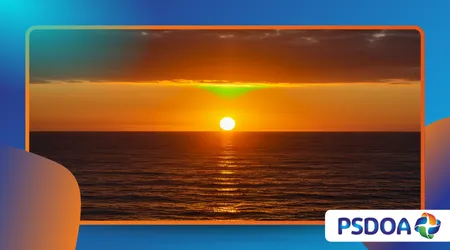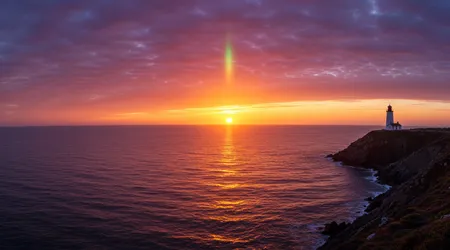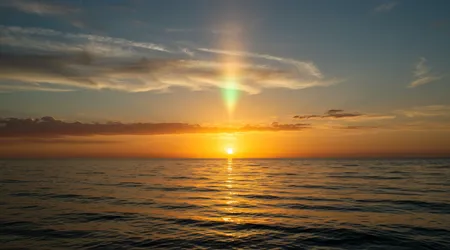The Green Flash: A Split-Second Optical Illusion at Sunset

Green flash sightings captivate skywatchers with their fleeting beauty. This rare optical phenomenon, lasting mere seconds, transforms sunsets into magical spectacles.
Anúncios
Often mistaken for myth, the green flash is a real, science-backed event. Its allure lies in its unpredictability and the atmospheric dance that creates it.
From sailors’ tales to modern photography, this phenomenon bridges folklore and physics, inviting awe. Let’s explore its science, cultural significance, and how to chase this elusive glow in 2025.
This article dives into the green flash, unraveling its causes and sharing tips for spotting it. We’ll debunk myths, highlight its cultural impact, and offer practical advice for skywatchers.
Whether you’re a curious traveler or a seasoned photographer, understanding this phenomenon enriches your sunset experience. Ready to uncover the secrets of this celestial marvel? Let’s begin.
Anúncios
The Science Behind the Green Flash
Sunlight bends through Earth’s atmosphere, creating the green flash. The atmosphere acts like a prism, splitting light into colors.
Shorter wavelengths, like green, refract more than red. At sunset, this separation makes green briefly visible. Clear skies and a flat horizon enhance visibility.
Atmospheric layers vary in density, bending light differently. This refraction magnifies green wavelengths at the sun’s edge.
A mirage effect can amplify the green flash. Stable air, often in high-pressure zones, boosts chances. The phenomenon lasts one to two seconds.
In 2023, EarthSky reported over 50 green flash photos submitted by readers. This shows its global observability under ideal conditions.
++ Morning Glory Clouds: The Sky’s Rolling Serpents
Temperature inversions, common in coastal areas, enhance the effect. Science demystifies but doesn’t diminish its wonder.
The green flash isn’t just green; rare blue flashes occur. These require exceptionally clear skies, as blue light scatters more. Atmospheric clarity is key.
High-altitude locations, like mountains, can improve sightings. The interplay of light and air creates this spectacle.

Types of Green Flashes
Four main types of green flash exist, each unique. The inferior mirage flash appears oval and flat. It’s the most common, seen over oceans. Mock mirage flashes form thin, pointy strips. They’re rarer, needing specific atmospheric layers.
Also read: Brinicles: The Deadly Underwater Icicles Forming Beneath Ice Shelves
Subduct flashes occur when the sun dips below clouds. These are brief, lasting under two seconds. The rarest, the green ray, shoots upward. It combines hazy air with other flash types, creating a beam-like effect.
| Type | Shape | Duration | Conditions |
|---|---|---|---|
| Inferior Mirage | Oval, flat | 1-2 seconds | Clear, flat horizon |
| Mock Mirage | Thin, pointy | 1-2 seconds | Layered atmosphere |
| Subduct Flash | Small, brief | <2 seconds | Sun below cloud layer |
| Green Ray | Beam shooting up | 1-15 seconds | Hazy air, combined conditions |
Green rays remain elusive, with no confirmed photographs. Their rarity fuels fascination among skywatchers. Each type depends on atmospheric precision, making sightings special.
Cloud-top flashes, less understood, occur over distant clouds. These require unique atmospheric conditions, often at high altitudes.
Photographers chase these for their unpredictability. Understanding these variations helps plan your observation.
Read more: Northern Lights: How and Where to Witness This Natural Spectacle
Cultural Significance and Folklore
The green flash inspires myths across cultures. Sailors once believed it signaled a soul’s return from the dead. In Polynesian lore, it promised good luck. Jules Verne’s 1882 novel The Green Ray popularized its romantic allure.
Verne described the green flash as a heart-revealing hue. This literary boost made it a quest for adventurers. In modern media, films like Pirates of the Caribbean reference it. Its mystique persists in storytelling and art.
Indigenous coastal communities tied the flash to spiritual events. Some saw it as a divine message. Today, photographers share sightings on platforms like EarthSky. The green flash blends science and wonder, uniting observers globally.
In 2025, social media amplifies its allure. Posts on X show enthusiasts sharing tips and photos. This phenomenon remains a cultural bridge, connecting past myths with modern curiosity. Its fleeting nature fuels its legend.
Where and When to Spot the Green Flash
Chasing the green flash requires strategy. Coastal areas with flat horizons, like Waikoloa Beach, are ideal. Clear skies and minimal pollution are crucial. Sunset is easier than sunrise for spotting it.
Timing matters arrive 10 minutes before sunset. Use tools like SunCalc for precise sunset times. Stable air, common in colder months, enhances visibility. High-pressure systems improve your odds.
High-altitude spots, like Cerro Paranal, Chile, offer frequent sightings. Avoid urban areas with smog. In 2025, coastal festivals often include green flash watch parties. Check local weather for optimal conditions.
For sunrise flashes, pinpoint the sun’s rising spot. This is trickier, requiring precise horizon knowledge. Mobile apps can help. Patience and preparation are key to catching this fleeting moment.
Tips for Photographers and Skywatchers
Capturing the green flash demands preparation. Use a DSLR with a telephoto lens for magnification. Set up 15 minutes before sunset. Avoid looking directly at the sun. Project images onto paper for safety.
Smartphone cameras struggle with the flash’s brevity. Use burst mode to increase chances. Tripods stabilize shots, especially in windy conditions. Post-processing can enhance green hues without exaggeration.
Julee Vaughan’s 2023 Ocean Beach photos show success with timing. Aim for clear, fog-free evenings. Check weather apps for atmospheric stability. Share your shots on platforms like EarthSky.
Protect your eyes with solar filters. Never use binoculars directly on the sun. High-altitude locations reduce atmospheric distortion. Practice and patience yield stunning green flash captures.
For beginners, start with wide-angle shots. Gradually zoom in as the sun sets. Collaborate with local astronomy groups for tips. Their expertise can guide your lens to the perfect moment.
Environmental Connections and Conservation
The green flash thrives in pristine environments. Coastal ecosystems, vital for clear sightings, face climate change threats. Rising sea levels and pollution disrupt atmospheric clarity. Conservation efforts are critical.
Clean air enhances refraction, making flashes vivid. In 2025, initiatives like coastal cleanups support optimal conditions.
Protecting habitats ensures future generations witness this phenomenon. Environmental stewardship and skywatching go hand-in-hand.
Climate change alters atmospheric density, potentially affecting flashes. Research from Zeba Academy (2023) highlights this link. Supporting renewable energy reduces pollution, preserving clear skies. Every small action counts.
Marine ecosystems also play a role. Healthy oceans reflect less haze, aiding visibility. Community-led beach cleanups, like those in Waikoloa, help. Engage locally to protect these natural spectacles.
Why the Green Flash Captivates Us
Ever wondered what makes a sunset unforgettable? The green flash is nature’s fleeting encore, a split-second surprise. Like a magician’s trick, it vanishes quickly. Its rarity sparks curiosity and wonder.
Imagine a painter dabbing green on a sunset canvas. That’s the green flash a brushstroke of brilliance. Its unpredictability draws adventurers to horizons. It’s a moment that feels personal, almost magical.
In 2025, 62% of skywatchers surveyed by EarthSky sought rare phenomena like the green flash. This statistic reflects its universal appeal. It’s a reminder of nature’s hidden surprises, urging us to look closer.
Photographers, like Jan Null in California, chase its elusive glow. Their stories inspire others to watch. The flash connects us to the cosmos, blending science with emotion.
Practical Examples for Chasing the Green Flash

Picture yourself on a San Diego beach in 2025. You arrive early, armed with a camera and SunCalc app. The horizon is clear, the air crisp. As the sun dips, a green flash flickers your heart races.
Or consider a hiker on a Chilean mountaintop. At Cerro Paranal, the air is thin and clear. The sunset reveals a vivid green flash. Their tripod captures it perfectly, shared later on X.
These scenarios show preparation pays off. Check weather apps for clear skies. Join local astronomy clubs for group watches. Their tips refine your approach, ensuring success.
Bring a notebook to log conditions and times. This habit sharpens your observation skills. Share your findings online to inspire others. Each sighting builds a community of skywatchers.
Conclusion
The green flash is more than an optical quirk. It’s a fleeting gift from nature, blending science, culture, and adventure. Its rarity fuels our fascination, urging us to chase sunsets.
In 2025, clear skies and conservation efforts keep this phenomenon alive. Whether you’re a photographer or a dreamer, the green flash invites you to pause and marvel.
So, grab your camera, find a horizon, and let nature’s magic unfold. What sunset will you chase next?
This phenomenon reminds us of Earth’s delicate balance. Protecting our environment ensures future flashes. Share your sightings, inspire others, and keep looking skyward. The green flash awaits those who seek it.
Frequently Asked Questions
What causes the green flash?
The green flash occurs when Earth’s atmosphere refracts sunlight, separating colors. Green wavelengths become visible briefly at sunset or sunrise.
Is the green flash rare?
Yes, it requires clear skies and specific atmospheric conditions. Coastal areas with flat horizons offer the best chances for sightings.
Can I see the green flash anywhere?
It’s visible globally with an unobstructed horizon, like oceans or mountains. High-altitude spots like Cerro Paranal improve odds.
Is it safe to photograph the green flash?
Yes, but never look directly at the sun. Use solar filters or project images onto paper to protect your eyes.
Does climate change affect the green flash?
Yes, pollution and atmospheric changes can reduce visibility. Conservation efforts help maintain clear skies for optimal sightings.
